Russian version
Ivanov A.G., Ushakov A.V.
Adaptive Control
in Three-Dimensional Linear Systems
with Dynamical Disturbance
of Unknown Level
Game Theory and Management
Second International Conference on Game Theory and Management
Download full text of the report (PDF format, 3374 KB)
Slide 1
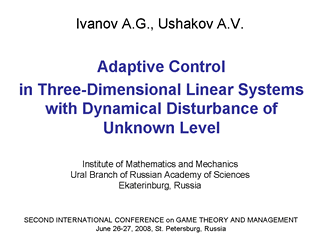
The first part of presentation is devoted to constructing the maximal stable
bridges in the three-dimensional (by the target set) linear differential game.
In the second part, the procedure elaborated is applied to building an adaptive
control in problems where there is no a priori geometric constraint for the second
player's control.
Slide 2
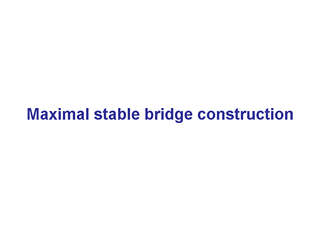
Maximal stable bridges construction
Differential game in the original space and the equivalent game
Slide 3
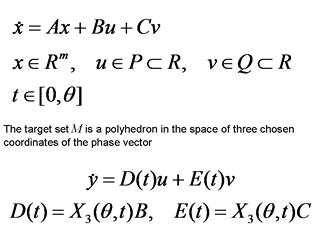
In the original game, the phase vector can have any dimension m ≥ 3, but the
convex target set depends only on three selected components of the phase vector.
By the standard change of variables, we pass to the equivalent differential game
of the third order without phase variables in the right-hand side of its dynamics.
We assume that the constraints P, Q onto the controls of the first and second
players are segments.
Approximating game
Slide 4
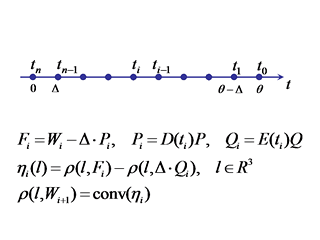
For constructing the maximal stable bridge in the approximating game, we divide
the time axis into a grid {ti} with the step Δ to the left from the termination
instant θ, and, under this, t0=θ.
On each time step, we "freeze" the dynamics of the equivalent system.
As a result, we obtain a collection of time sections (t-sections)
Wi=W(ti) ⊂ R3
of the approximating maximal stable bridge W.
The construction of the time sections is implemented in a backward procedure:
in the first step, on the basis of the target convex polyhedron, a convex polyhedron
W1 is built; in the second step, on the basis of
the polyhedron W1,
a convex polyhedron W2 is built, and so on.
The construction of each next section Wi+1 of the
bridge includes operations with convex polyhedrons, namely, constructing
the algebraic sum (Minkowski sum) Fi of the polyhedron
Wi and the segment
−Δ·Pi
(this takes into account the action of the first player) and
constructing the geometric difference (Minkowski difference)
of the polyhedron
Fi
and the segment
Δ·Qi
(this takes into account the action of the second player).
The latter procedure is equivalent to building the convex
hull of the difference
ρ(·, Fi) − ρ(·, Δ·Qi)
of the support functions of the sets
Fi
and
Δ·Qi.
For a continuous, positive homogeneous, and piecewise linear function
γ : l → γ(l)
with convex cones of linearity, we use the following representation:
on the unit sphere S, we introduce a grid (graph)
G(γ),
which is defined by
the intersection of the sphere with the linearity cones
of the function γ.
At each node of G(γ),
the value of the function γ is written.
When constructing the support function
ρ (·, Wi+1)
of the polyhedron Wi+1,
we require that all linearity cones of the function
ρ(·, Wi)
are three-edged and,
respectively, the cells of the grid
G(ρ(·, Wi))
are triangular. For this,
it is necessary to triangulate the initial grid,
and further, when constructing new grids, to apply (if necessary) additional
triangulation of the grid.
Taking into account action of the first player
Slide 5
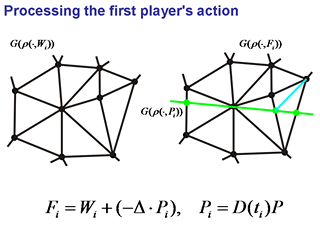
The grid
G(ρ(·, Fi))
is the result of overlapping the grids
G(ρ(·, Wi))
and
G(ρ(·, Pi)).
Since Pi is a segment in R3,
the graph
G(ρ(·, Pi))
is a circumference on the sphere S,
i.e., the intersection of the sphere and the plane passing through the origin and
orthogonal to Pi.
When overlapping the grids, new nodes appear.
So, when constructing the grid
G(ρ(·, Fi)),
we establish additional links to provide
the linearity cones of the function
ρ(·, Fi) to be three-faced.
Taking into account action of the second player
Slide 6
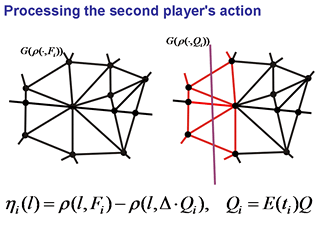
We recompute values of the support function
ρ(·, Fi)
at the nodes of the grid
G(ρ(·, Fi))
with taking into account action of the second player, and we obtain
a function ηi(·).
To pass to the support function of the polyhedron Wi+1,
it is necessary to
exclude the nodes of the graph
G(ρ(·, Fi)),
where the convexity of the function
ηi(·)
is violated.
To implement the convexification, a special iterative procedure was elaborated.
Collect "suspicious" links into a list.
Initially, we put there that links of the grid
G(ρ(·, Fi)),
which intersect with the graph
G(ρ(·, Qi)),
and links in incident to them.
Further, a correction of these links is implemented;
this procedure corrects
the violations of the local convexity.
Under this, the list of suspicious links can be added
with other links.
Vice versa, the links, where the local convexity takes place,
are excluded from the list.
This process is ceased when the list of suspicious links becomes empty.
Groundwork
Slide 7
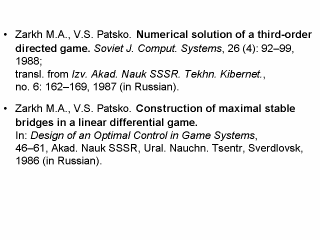
To elaborate the algorithm for constructing the maximal stable bridge, we
used ideas from the cited papers.
Algorithm of constructing the maximal stable bridge
Slide 8
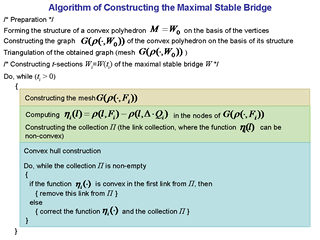
The scheme of the algorithm for constructing the stable bridge is presented. It is based
on the stepwise procedure for building the time sections.
The iterative procedure of convexification is the most expensive in computations of
each next section.
Model examples
Slide 9
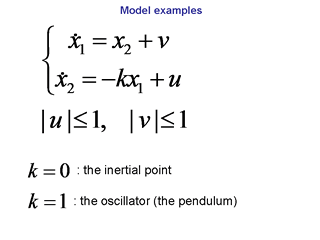
In the case k = 0, the dynamics shown in the slide
describes
the motion of an inertial point
along the direct line. In the case
k = 1,
a conflict-controlled oscillator is
described. The first player governs the control u, the second player governs
the control v.
Finding the value function in a two-dimensional game
(by means of a three-dimensional bridge)
Slide 10
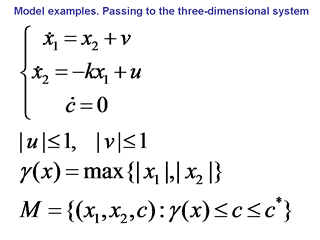
In a two-dimensional game with fixed termination instant, the terminal
payoff function γ is taken as
γ(x) = max{|x1|, |x2|}.
We are
interested to get the value function.
To construct the epigraph of the value function, consider a game of the third
order with the target set M as the cut-off
(at a level c*) of the epigraph of the
payoff function for the two-dimensional game.
Then, a t-section of the
bridge of the three-dimensional game will be the cut-off
(at the level c*)
of the epigraph of the
value function for the two-dimensional game at the same instant t.
Target set
Slides 11, 12

Here, the target set of the three-dimensional game is presented: side view and bottom view.
Time sections of the bridge for several instants
Slides 13–22
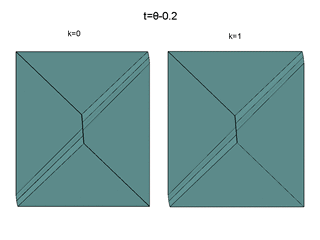
Here, the t-section of the bridges
for different instants are presented for
the considered three-dimensional games: at the left, for the inertial point;
at the right, for the pendulum.
These are views from "below", i.e., from the side
of negative values of the c-axis.
Slide 23

Adaptive control
Adaptive control
Slide 24
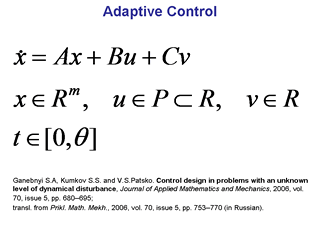
We consider a problem of constructing an adaptive control in linear
systems with unknown level of the dynamic disturbance.
The aim of useful control is to guide
n selected components of the phase vector to a convex bounded
target set at the fixed terminal instant θ.
The useful control obeys a geometric
constraint.
The dynamic disturbance (the second player's control) is assumed to
be bounded, but the level of its constraint is unknown a priori.
Principle of the adaptive control
Slide 25
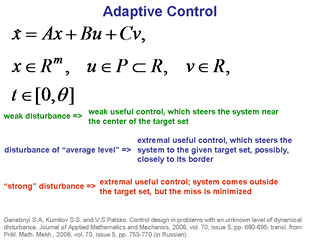
Here, the requirements to the adaptive control are presented.
Family of stable bridges for constructing adaptive control
Slide 26
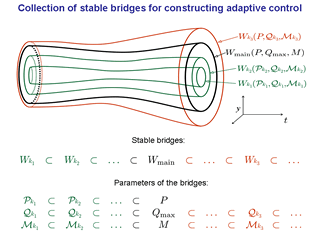
An ordered family of the stable bridges is considered.
Each bridge is defined
by a triple: the constraint for the first player's control, the constraint
for the second player's control, and the target set.
The main bridge Wmain corresponds to the triple P,
Qmax, and M.
Here, the sets P and M are given by the problem formulation,
and the set Qmax is chosen by us and can be treated
as a constraint for the disturbance, which
is assumed to be "reasonable"
in the problem under consideration.
We assume that each of the sets P,
Qmax, and M
contains the origin of its space.
For the case n = 2, the algorithms for constructing the adaptive control were
worked out earlier. The picture of
the embedded system of bridges is
presented just for such a case.
In this work, we consider the case of a three-dimensional target set.
Therefore, the t-sections of bridges are also three-dimensional. For
constructing the bridges, we use the algorithm described in the first part of
the presentation.
Simulation of the adaptive control
Slides 27–43
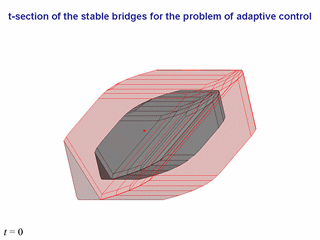
Now, let us present the simulation results for some dynamic system (we do not
write it).
To construct the adaptive control, we use the principle of extremal
aiming well-known in the theory of differential games.
The adaptive
control is used for the first player; a random disturbance plays the role of
the second player's control.
The following sequence of slides shows the behavior of the phase state of the
system with respect to the t-sections of the main bridge.
In the initial interval of time, the phase point is out of the main bridge
(it is the red colored point).
Therefore, for constructing the adaptive
control, t-sections of outer bridges are used.
The pink color shows the section, which is used for the extremal
aiming in the procedure of the adaptive control generating.
At some instant, the phase point comes inside the main bridge (when inside,
the point is colored in orange).
In such situations, only the t-sections
of the main bridge is shown, though the control is implemented by aiming to
the t-section of some smaller bridge.
The
t-section of that bridge is computed very simply, namely, with
direct multiplication of the corresponding t-section of the main bridge
by an appropriate coefficient k < 1.
At the left low corner of each slide, the corresponding instant is presented.
The neighbor slides with the same instant
differ from each other by
the point of view.
In passage from one instant to the next, the point of view does not change.
A.G.Ivanov, A.V.Ushakov
Institute of Mathematics and Mechanics
Ekaterinburg, Russia
iagsoft@imm.uran.ru
Patsko sector homepage
















